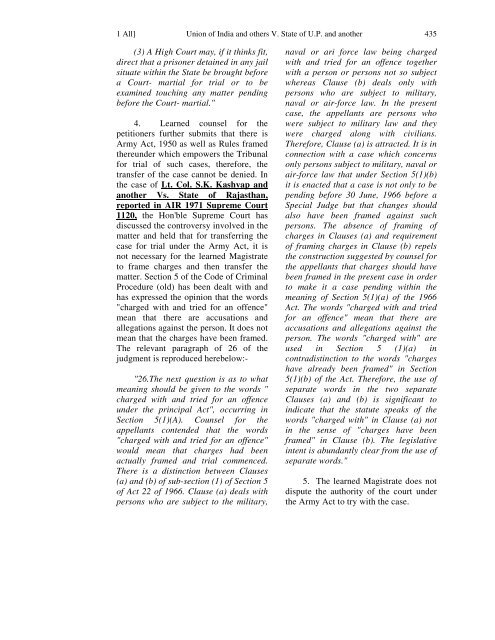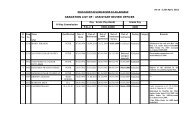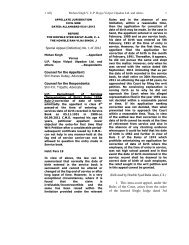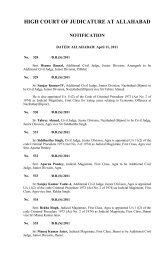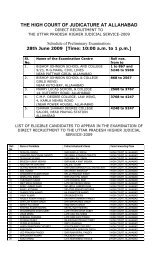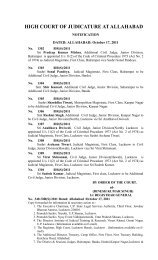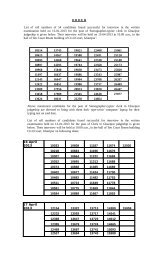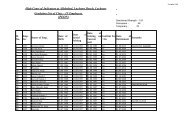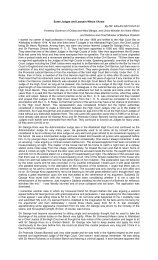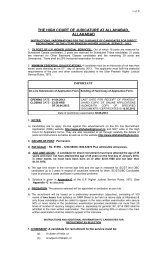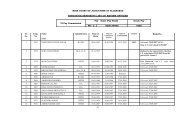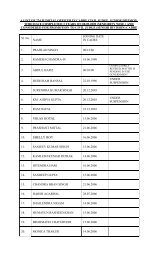Apr - High Court of Judicature at Allahabad
Apr - High Court of Judicature at Allahabad
Apr - High Court of Judicature at Allahabad
Create successful ePaper yourself
Turn your PDF publications into a flip-book with our unique Google optimized e-Paper software.
1 All] Union <strong>of</strong> India and others V. St<strong>at</strong>e <strong>of</strong> U.P. and another 435<br />
(3) A <strong>High</strong> <strong>Court</strong> may, if it thinks fit,<br />
direct th<strong>at</strong> a prisoner detained in any jail<br />
situ<strong>at</strong>e within the St<strong>at</strong>e be brought before<br />
a <strong>Court</strong>- martial for trial or to be<br />
examined touching any m<strong>at</strong>ter pending<br />
before the <strong>Court</strong>- martial."<br />
4. Learned counsel for the<br />
petitioners further submits th<strong>at</strong> there is<br />
Army Act, 1950 as well as Rules framed<br />
thereunder which empowers the Tribunal<br />
for trial <strong>of</strong> such cases, therefore, the<br />
transfer <strong>of</strong> the case cannot be denied. In<br />
the case <strong>of</strong> Lt. Col. S.K. Kashyap and<br />
another Vs. St<strong>at</strong>e <strong>of</strong> Rajasthan,<br />
reported in AIR 1971 Supreme <strong>Court</strong><br />
1120, the Hon'ble Supreme <strong>Court</strong> has<br />
discussed the controversy involved in the<br />
m<strong>at</strong>ter and held th<strong>at</strong> for transferring the<br />
case for trial under the Army Act, it is<br />
not necessary for the learned Magistr<strong>at</strong>e<br />
to frame charges and then transfer the<br />
m<strong>at</strong>ter. Section 5 <strong>of</strong> the Code <strong>of</strong> Criminal<br />
Procedure (old) has been dealt with and<br />
has expressed the opinion th<strong>at</strong> the words<br />
"charged with and tried for an <strong>of</strong>fence"<br />
mean th<strong>at</strong> there are accus<strong>at</strong>ions and<br />
alleg<strong>at</strong>ions against the person. It does not<br />
mean th<strong>at</strong> the charges have been framed.<br />
The relevant paragraph <strong>of</strong> 26 <strong>of</strong> the<br />
judgment is reproduced herebelow:-<br />
"26.The next question is as to wh<strong>at</strong><br />
meaning should be given to the words "<br />
charged with and tried for an <strong>of</strong>fence<br />
under the principal Act", occurring in<br />
Section 5(1)(A). Counsel for the<br />
appellants contended th<strong>at</strong> the words<br />
"charged with and tried for an <strong>of</strong>fence"<br />
would mean th<strong>at</strong> charges had been<br />
actually framed and trial commenced.<br />
There is a distinction between Clauses<br />
(a) and (b) <strong>of</strong> sub-section (1) <strong>of</strong> Section 5<br />
<strong>of</strong> Act 22 <strong>of</strong> 1966. Clause (a) deals with<br />
persons who are subject to the military,<br />
naval or ari force law being charged<br />
with and tried for an <strong>of</strong>fence together<br />
with a person or persons not so subject<br />
whereas Clause (b) deals only with<br />
persons who are subject to military,<br />
naval or air-force law. In the present<br />
case, the appellants are persons who<br />
were subject to military law and they<br />
were charged along with civilians.<br />
Therefore, Clause (a) is <strong>at</strong>tracted. It is in<br />
connection with a case which concerns<br />
only persons subject to military, naval or<br />
air-force law th<strong>at</strong> under Section 5(1)(b)<br />
it is enacted th<strong>at</strong> a case is not only to be<br />
pending before 30 June, 1966 before a<br />
Special Judge but th<strong>at</strong> changes should<br />
also have been framed against such<br />
persons. The absence <strong>of</strong> framing <strong>of</strong><br />
charges in Clauses (a) and requirement<br />
<strong>of</strong> framing charges in Clause (b) repels<br />
the construction suggested by counsel for<br />
the appellants th<strong>at</strong> charges should have<br />
been framed in the present case in order<br />
to make it a case pending within the<br />
meaning <strong>of</strong> Section 5(1)(a) <strong>of</strong> the 1966<br />
Act. The words "charged with and tried<br />
for an <strong>of</strong>fence" mean th<strong>at</strong> there are<br />
accus<strong>at</strong>ions and alleg<strong>at</strong>ions against the<br />
person. The words "charged with" are<br />
used in Section 5 (1)(a) in<br />
contradistinction to the words "charges<br />
have already been framed" in Section<br />
5(1)(b) <strong>of</strong> the Act. Therefore, the use <strong>of</strong><br />
separ<strong>at</strong>e words in the two separ<strong>at</strong>e<br />
Clauses (a) and (b) is significant to<br />
indic<strong>at</strong>e th<strong>at</strong> the st<strong>at</strong>ute speaks <strong>of</strong> the<br />
words "charged with" in Clause (a) not<br />
in the sense <strong>of</strong> "charges have been<br />
framed" in Clause (b). The legisl<strong>at</strong>ive<br />
intent is abundantly clear from the use <strong>of</strong><br />
separ<strong>at</strong>e words."<br />
5. The learned Magistr<strong>at</strong>e does not<br />
dispute the authority <strong>of</strong> the court under<br />
the Army Act to try with the case.


